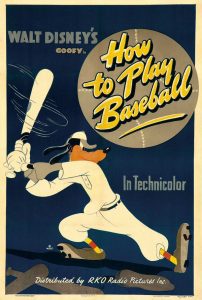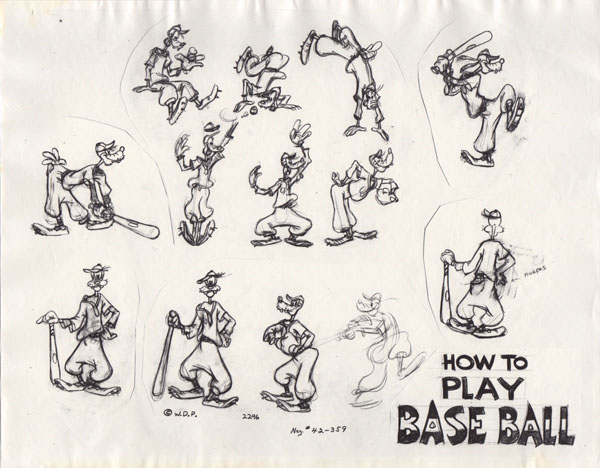
A still frame from HOW TO PLAY BASEBALL (1942) directed by Jack Kinney, animation by Ward Kimball, layout by Al Zinnen; Prod. #2296, scene 43.1; ©Disney
I will tell you right up front that I am not a fan of baseball. In fact, I’ve never been to a professional baseball game in my entire life. Several people have tried to remedy that in recent years but I have declined the offers. Recently though, there has been a lot of talk amongst some of my friends about how well the Dodgers have been playing this year, or at least they were as of this writing. That made me think of Disney’s Goofy “Art of” and “How to” shorts that were made during the Golden Age of animation. I wrote about these wonderful comic “instructional” films several years ago as they stand out as great examples of Disney character animation at its finest.
 Goofy’s How to Play Baseball was the first short of the original series of “How To” cartoons produced between 1942 and 1953, ten in all. There were other instructional shorts created during that time period including “The Art of” shorts and several others that fit the same mold like Hockey Homicide and The Olympic Champ among others.
Goofy’s How to Play Baseball was the first short of the original series of “How To” cartoons produced between 1942 and 1953, ten in all. There were other instructional shorts created during that time period including “The Art of” shorts and several others that fit the same mold like Hockey Homicide and The Olympic Champ among others.
In 1942, a year after beloved Yankee first baseman Lou Gehrig died of amyotrophic lateral sclerosis (ALS), The Pride of the Yankees produced by Samuel Goldwyn and starring Gary Copper as Gehrig was released to a nation that mourned the loss of a sports legend. While the film was in production, Goldwyn “sent Disney a script on the picture to read with the idea of creating” a cartoon specifically to be released with his baseball picture. Walt immediately envisioned Goofy “as the animated counterpart to Gary Cooper,” according to company documents.
How to Play Baseball featured Goofy as the everyman playing all positions and explained in comic terms the rules of the game. The cartoon describes all the basics of the game including the quirky actions of the pitcher and other players, and then moves onto a fictitious World Series game in progress between the Gray Sox and the Blue Sox. The studio had a technical advisor in story artist George Stallings whose father managed the then Boston Braves and he had spent a summer helping to manage the team. The short concludes with a play too close to call at home base, which leads to an argument between the umpire and two rival players, which George likely had some experience with!
This short showcases some wonderful animation by four of Disney’s Nine Old Men– Les Clark, Ward Kimball, Ollie Johnston, and Marc Davis, as well as Disney legend Vladimir “Bill” Tytla and several other animators.
Near the beginning of the short as the narrator describes some of the baseball terminology, Tytla displays his animation acumen in a group of hilarious action scenes with Goofy swinging at various curve balls, bunting, and a terrific scene with a spit ball that actually spits in Goofy’s face.

Marc Davis by contrast was charged with more subtle and expressive acting scenes like Goofy frowning and taking a bite out of the baseball instead of a block of chewing tobacco.
There is also a great sequence of scenes animated by Ward Kimball in which Goofy as the pitcher beans the batter in the head with the pitch. Cock-eyed dizzy, a large bump pops out of the top of the batter’s head. In a punchy way, he staggers and then somersaults down the baseline picking up bats and other equipment along the way towards first base eventually landing upside down. It shows off Kimball’s masterful comic timing.
 Art Babbitt, who helped develop Goofy, described the character as “a composite of an everlasting optimist, a gullible Good Samaritan, a half-wit, a shiftless…. good-natured, dumb bell what thinks he is pretty smart… He laughs at his own jokes because he can’t understand any others… He talks to himself because it is easier for him to know what he is thinking if he hears it first.” Goofy has all those characteristic traits that truly make him the everyman, an amalgam of flaws, foibles, quirks, and idiosyncrasies that we can relate to.
Art Babbitt, who helped develop Goofy, described the character as “a composite of an everlasting optimist, a gullible Good Samaritan, a half-wit, a shiftless…. good-natured, dumb bell what thinks he is pretty smart… He laughs at his own jokes because he can’t understand any others… He talks to himself because it is easier for him to know what he is thinking if he hears it first.” Goofy has all those characteristic traits that truly make him the everyman, an amalgam of flaws, foibles, quirks, and idiosyncrasies that we can relate to.
All of those traits are on full display in How to Play Baseball, a quintessential Goofy cartoon that one critic in 1942 called a “…deliciously confused Disney cartoon, a goofy burlesque….” It’s not the first time that Disney created a cartoon based on a popular event, pastime, or individual, which has touched the nation psyche. The 1929 Mickey Mouse cartoon Plane Crazy capitalized on the popularity of aviation pioneer Charles Lindbergh, the 1928 Steamboat Willie was a parody of the Buster Keaton film Steamboat Bill Jr., and the 1949 Goofy Gymnastics, which came out a year after the summer Olympics in London. So it was no surprise that Samuel Goldwyn asked Walt Disney to create a baseball themed Goofy cartoon to open at the head of his picture The Pride of the Yankees. Now it’s time to, play ball! Well not really for me, but you go right ahead.


 David A. Bossert is an award-winning artist, filmmaker, and author. He received his B.A. from CalArts School of Film and Video with a major in Character Animation. As a 32-year veteran of The Walt Disney Company, he contributed his talents to The Black Cauldron (1985), Who Framed Roger Rabbit (1988), The Little Mermaid (1989), Beauty and the Beast (1991), Aladdin (1992), Tim Burton’s The Nightmare Before Christmas (1993), The Lion King (1995), Fantasia/2000 (1999), and the Academy Award-nominated shorts Runaway Brain (1995), Dali/Disney Destino (2003), and Lorenzo (2004), among many others. Bossert is now an independent producer, creative director, and writer.
David A. Bossert is an award-winning artist, filmmaker, and author. He received his B.A. from CalArts School of Film and Video with a major in Character Animation. As a 32-year veteran of The Walt Disney Company, he contributed his talents to The Black Cauldron (1985), Who Framed Roger Rabbit (1988), The Little Mermaid (1989), Beauty and the Beast (1991), Aladdin (1992), Tim Burton’s The Nightmare Before Christmas (1993), The Lion King (1995), Fantasia/2000 (1999), and the Academy Award-nominated shorts Runaway Brain (1995), Dali/Disney Destino (2003), and Lorenzo (2004), among many others. Bossert is now an independent producer, creative director, and writer.













































































As the initial cartoon in the series, it’s not as quickly paced as some of Kinney’s later sports cartoons. But it does give him and the others on the Disney staff their first chance to step into the world of Tex Avery’s topic-specific spot gag cartoons with the added spin of creating a whole world of Goofys (Avery already had done a sports parody cartoon in 1939’s “Screwball Football” and would do his own baseball themed spot gag effort two years after Disney’s version came out, that deliberately sought to start it’s pacing at the level Disney’s baseball effort left off at, with the action coming even before the MGM titles).
This is a terrific cartoon, one of the reasons why I like the Goof in his “hot to” pictures. Strange that Samuel Goldwyn wouldn’t turn to his own MGM animators to produce a baseball-themed cartoon, but, yes, this is the Disney studio’s attempt at the kind of pacing that Tex Avery would later take to new levels and had already started to take to that level with his Warner Brothers titles.
OK, but Samuel Goldwyn’s only involvement with MGM was his name supplying the G between the M’s. MGM’s head of production was Louis B. Mayer.
Samuel Goldwyn Productions was an independent studio because Metro and Mayer bought out Goldwyn’s initial studio. In reading the new Richard Sandomir book on the making of the Pride of the Yankees it seems Goldwyn was not a baseball fan, and didn’t want to advertise the movie as a baseball movie, so I thought it was interesting that they’d commission a baseball themed sort from Disney
That’s strange, Dave, I always thought that “How To Ride A Horse”, released June 20, 1941 as part of “The Reluctant Dragon”, was the first of the Goofy “How To” cartoons. Also, “The Art Of Skiing” and “The Art of Self Defense” released in November and December of 1941, could certainly qualify as “How To” cartoons, since they are mock instructional films on skiing and boxing, respectively.
Mark, the “Art of” and “How to” cartoons are considered separate series even though they may be similar in theme. The first “How to” cartoon released as a standalone cartoon was How to Play Baseball on September 4, 1942. The How to Ride a Horse cartoon was part of The Reluctant Dragon film and was not released as a separate, standalone theatrical cartoon until February 1, 1950. So yes, How to Play Baseball is the first Goofy “How to” theatrically released short in the series. Thanks for reading the piece and for your comments.
A few comments from a die-hard baseball fan…
(1) Note the design of the stadium shown around 0.50. At this time, ca. 1942, a lot of baseball stadiums were inner-city affairs, and many had designs that were reflections of the oddly-shaped property lines. Most stadiums in use at this time were built (or rebuilt) in the period 1905-1925. Eventually, the kind of design where there were no outfield seats would disappear, as new stadiums were built in the 1950s, 1960s and 1970s, replacing the likes of Shibe Park, Forbes Field, Sportsman’s Park, &c.
(2) The joke at 1.30 about socks giving the name to the team is, of course, an exaggeration. Of the 16 major league teams in 1942, only two (Chicago White Sox, Boston Red Sox) had “sox” in the name. Two others (Cincinnati Reds, St. Louis Browns) had names that were allusions to the socks worn by the team (or predecessor teams) in previous years. The Reds, during the Red Scare era of the 1950s, went back to using “Red Stockings” for some years.
(3) The spitball (referred to at 3.45) was outlawed in major league baseball in 1920, though certain players that used it as part of their regular selection of pitches were allowed to use it; the last of these retired in 1934. However, as this cartoon demonstrates, the spitball remained a part of baseball lore long after, and assorted scandals about doctoring baseballs continued for decades afterward. In reality, few pitchers actually spat on the ball; many used substances like slippery elm or Vaseline, giving rise to a related pitch called the “shine ball.”
(4) At the time this cartoon came out, no no-hitter had ever been thrown in a World Series game. However, in 1956, Don Larsen famously threw a perfect game against the Dodgers for the Yankees, and previously, in 1947, another Yankees pitcher almost threw one, also against the Dodgers (he ended up losing the game).
(5) The “$500,000” figure cited is actually not far from the truth. For the 1942 World Series, the players shared in a pool of $427,000, winning players getting just under $6,200.